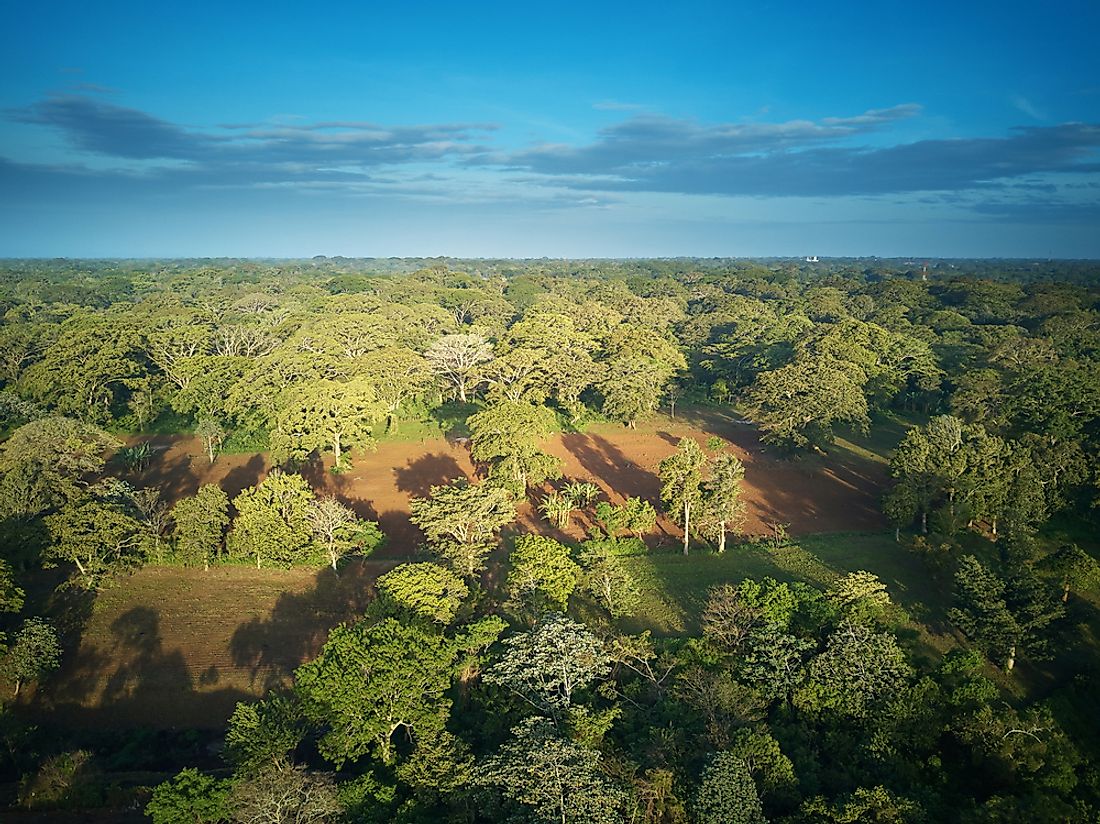Ecological Regions Of Nicaragua

Nicaragua, officially known as the Republic of Nicaragua is located in Central America with its capital Managua being the country’s largest city. It covers an estimated area of 50,193 square miles with a population of 6 million with different ethnic groups who speak either Spanish or their native language. It is a naturally diverse country being home to 24 volcanoes, several lakes, rivers, and lagoons as well as ecological regions like the rainforest, the dry forest, and the mangrove forest.
Eco Regions of Nicaragua
Central American Atlantic Moist Forest
This ecoregion is found in the southern part of Nicaragua covering the lowland Atlantic slopes and represents the perfect example of the wet tropical jungle. Distinct tall tropical evergreen forests grow up to 164 feet in height and a good amount of short palms form a great sub-canopy. Humidity and precipitation are high in this region due to the warm air from the Caribbean Sea. From the treetops, monkeys can be seen swinging from one tree to the other while jaguars could be found in the swampy sub-canopy hunting. Deforestation is a major threat to the clearing of these forests, and slow-growing trees face extinction if this continues.
Central American Pine-Oak Forests
The Central American pine-oak forests are found in the mountain region of Central America covers a total area of 43,000 square miles. They lie in the higher elevations of around 2,000-5,900 feet and are surrounded by the tropical moist forest and tropical dry forests at the lower elevations. The forest is composed of several species of flora; these include the oaks, pines, fir, and the cypress. Its biome is the tropical and subtropical coniferous forests and is listed as an endangered ecoregion
Isthmian-Atlantic Moist Forest
The Isthmian-Atlantic moist forests are located in Nicaragua covering an area of 22,700 square miles. This ecoregion is the tropical moist broadleaf forest lying in the temporal regions of America and the entire South American temperate zones. The region is located in the Atlantic lowland regions with a slightly lower elevation of 16,480 feet. The warmest months range between March and May while the coldest are November to January and the tall evergreen trees grow to 124 feet tall to form a canopy while the slow-growing trees like the cream nut tree form the canopy. The mammal species found in the forest are unique only to the ecoregion like the Snowy Cotinga. It is a vulnerable ecoregion. Therefore, efforts to protect it have been enforced to prevent deforestation.
Central American Montane Forests
The Central American montane forests are tropical and subtropical moist broadleaf forests that are located in the highest mountainous regions of Central America. They grow in an elevation between 5,900 to 13,100 feet covering a total area of 5,100 square miles. The precipitation levels of this ecoregion are high, but the climate is temperate. It has been listed as a vulnerable ecoregion due to deforestation.
Environmental Threats
Deforestation is a major threat to the clearing of these forests, and slow growing trees face extinction if it is not controlled. Global warming is also a threatening these ecosystems as wildlife migrate in search of conducive environment.
Ecological Regions Of Nicaragua
| Ecological Regions of Nicaragua | Biome |
| Cayos Miskitos-San Andrés and Providencia moist forests | Tropical and Subtropical Moist Broadleaf Forests |
| Central American Atlantic moist forests | Tropical and Subtropical Moist Broadleaf Forests |
| Central American dry forests | Tropical and Subtropical Dry Broadleaf Forests |
| Central American montane forests | Tropical and Subtropical Moist Broadleaf Forests |
| Central American pine-oak forests | Tropical and Subtropical Coniferous Forests |
| Chiapas - Fonseca | Tropical and Subtropical Coastal Rivers |
| Chiapas-Nicaragua | Tropical East Pacific Marine |
| Costa Rican seasonal moist forests | Tropical and Subtropical Moist Broadleaf Forests |
| Estero Real-Tempisque | Tropical and Subtropical Coastal Rivers |
| Gulf of Fonseca mangroves | Mangroves |
| Isthmian-Atlantic moist forests | Tropical and Subtropical Moist Broadleaf Forests |
| Miskito pine forests | Tropical and Subtropical Coniferous Forests |
| Mosquitia | Tropical and Subtropical Coastal Rivers |
| Mosquitia-Nicaraguan Caribbean Coast mangroves | Mangroves |
| Rio Negro-Rio San Sun mangroves | Mangroves |
| San Juan | Tropical and Subtropical Coastal Rivers |
| Southern Dry Pacific Coast mangroves | Mangroves |
| Southwestern Caribbean | Tropical Northwestern Atlantic Marine |







